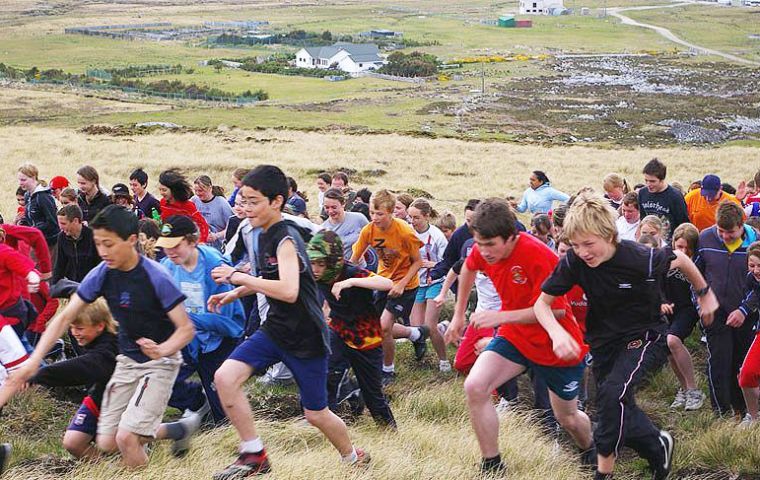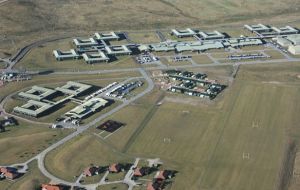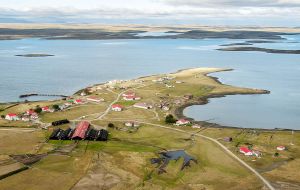MercoPress. South Atlantic News Agency
Falklands' 2016 Census (I): Population 3.200; Camp increased 9%, for the first since 1950s'
 The 2016 census shows that Falklands population increased by 360 people over the four years since the April 2012 census, reaching 3,200 persons in October 2016. (Pic PN)
The 2016 census shows that Falklands population increased by 360 people over the four years since the April 2012 census, reaching 3,200 persons in October 2016. (Pic PN)  If the civilian population of 359 people based at MPA is not taken into account, the population has increased by 370 persons, or 14.9%, from 2,471 to 2,841 in 2012/16.
If the civilian population of 359 people based at MPA is not taken into account, the population has increased by 370 persons, or 14.9%, from 2,471 to 2,841 in 2012/16.  The population in Camp grew for the first time since the 1950s: 9% overall. Goose Green, Fitzroy and North Arm are the most populated settlements on the East (Pic T. Mooney)
The population in Camp grew for the first time since the 1950s: 9% overall. Goose Green, Fitzroy and North Arm are the most populated settlements on the East (Pic T. Mooney) The Falkland Islands government Policy and Economic Unit has released the 2016 Census Report (*) which indicates that the total number of people counted in the Islands on census night, 9 October 2016, was 3,354. This figure includes visitors to the Islands and people who are not normally resident in the country, for example tourists or crew on vessels in Falklands waters on census night.
The number of people that usually live in the Islands but who were overseas at the time of the census was calculated to be 198 persons, and if this is added to the usually resident and present figure it gives a total population count of 3,398. However, when reporting census data the convention is to report on the de jure or usually resident population present on the night of census. Thus, all of the figures reported will relate to the population of 3,200.
The 2016 census shows that the Falkland Islands population increased by 360 people over the four years since the previous census in April 2012, reaching 3,200 persons in October 2016.
This represents a total increase of 12.7% over the four years, or 3.2% on an annual average basis. This compares with an annual average decrease of 3.9% over the previous intercensal period 2006 to 2012.
If the civilian population of 359 people based at Mount Pleasant Complex, MPA, is not taken into account, the population in the rest of the Islands has increased by 370 persons, or 14.9%, from 2,471 in 2012 to 2,841 in 2016.
Population growth was not evenly distributed across all locations. The population in the capital Stanley increased by 16%; West Falkland grew by 19%; and the population of the outer islands doubled in size. The population of East Falkland decreased by 6%, and the civilian population at MPC fell by 3%.
The population in Camp grew for the first time since the 1950s; by 9% overall. Goose Green, Fitzroy and North Arm are the most populated settlements on the East; Fox Bay, Port Howard and Hill Cove are the largest on the West.
The Falkland Islands population declined throughout the 1950s and up to the 1980s, before beginning to increase in the late 1980s. Almost 1,400 people were added to the population between 1986 and 2016, and 1996 was the first time the civilian population at MPC were counted in a census accounting for 94% of the population increase in that year.
Net migration is the most influential driver of population change in the Falkland Islands and is the sole determinant of long term population change. Net migration accounted for 70 to 89% of total demographic change since the 1980s.
As to the population composition there were 1,449 males and 1,390 females present on Census Night (1,687 males and 1,449 females including MPC), giving a sex ratio of 111.6 males for 100 females.
Young people aged 0 to 14 years make up 18% of the population, those aged 15 to 64 years comprise 71%, and those aged 65 years and over make up 11%.
The average age of the population is 38 years. The number of people aged 65 years and over increased by 16%, indicating that people are living longer. There is a tendency towards an older population in Camp, particularly in East Falkland and in the outer islands.
The total dependency ratio (the ratio of young and old to the working age population) is 46%, meaning that there are 2.2 working age people for every dependent person. This compares favorably with the UK for example, where the ratio is 55% or 1.8 working age people for every dependent person.
The working age population was bolstered by the addition of 518 people with temporary immigration status; an increase of 59% on 2012 (325 persons). This had the effect of reducing the dependency ratio by 9%.
As to households and families, excluding MPC, 1,189 occupied houses were counted on Census Night; 1,026 in Stanley and 163 in Camp. The average household size is 2.4 persons, a slight increase on the 2.2 average in 2012.
Couples without children are the dominant household type in the Falkland Islands at 29%, followed by couples with children, and one person households at 27% each. Single parents with one or more children make up 8%, and non nuclear households (where residents are unrelated to each other) comprise the remaining 10%.-
There are 350 persons aged 65 years and over, of whom one third are living alone. Women are more likely to be widowed and living alone than men, and this reflects the higher mortality rate for males. Older adults in Stanley are more likely to live alone than their counterparts in Camp.
The proportion of the population that has never married remained relatively stable since 2012 at 28%. Those aged 15 to 34 years are most likely to be cohabiting, and people over 35 years of age are most likely to be married. People living in Camp are more likely to be cohabiting or married than people living in Stanley, and this reflects the older age profile in Camp.
There are 636 children aged 17 years and under with an approximately even split of males and females. 379 family households have children living with them, and 179 households have children aged 5 years and under. The average number of children per family household was 1.6 overall; 1.8 children in Camp and 1.6 in Stanley.
(*) The Falklands population took place on the night of Sunday 9th October 2016 in accordance with the Statistics Ordinance (No 10 of 2010), marking the 24th conducted in the Falklands since the first census was carried out by a resident Governor in the Islands in 1842.
This report is the second of two publications on the results of the 2016 census. The first was published in February 2017 and provided a summary of the headline results. This second report details the full findings of the 2016 Census and presents the results across seven key themes.
The census provides a snapshot in time of the people living in the Falkland Islands, and the findings build a picture of the social and cultural life of people living in a remote but thriving community.




Top Comments
Disclaimer & comment rules-

-

-

Read all commentsFor all those that wish to suggest that it is just outsiders that is boosting the Falklands population, perhaps I should remind you that the UK's population has been increased by 250,000 every year for the last 12 years by immigration.
Jul 22nd, 2017 - 12:29 pm +7Seems normal enough.
Dear oh dear. Isn't a big part of the Malvinista's argument that we're all put here by England? It would seem we're not...and before any of you deadbeats challenge the figure...they weren't thrown together by Crissy's INDEC.
Jul 22nd, 2017 - 03:09 pm +4Chuckle chuckle.
Think
Jul 22nd, 2017 - 04:45 pm +4Clarification needed . What is your point ?
Commenting for this story is now closed.
If you have a Facebook account, become a fan and comment on our Facebook Page!